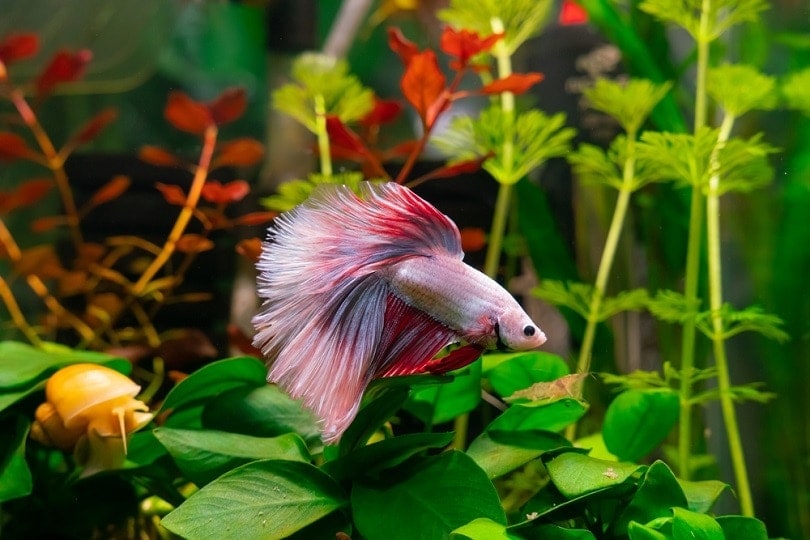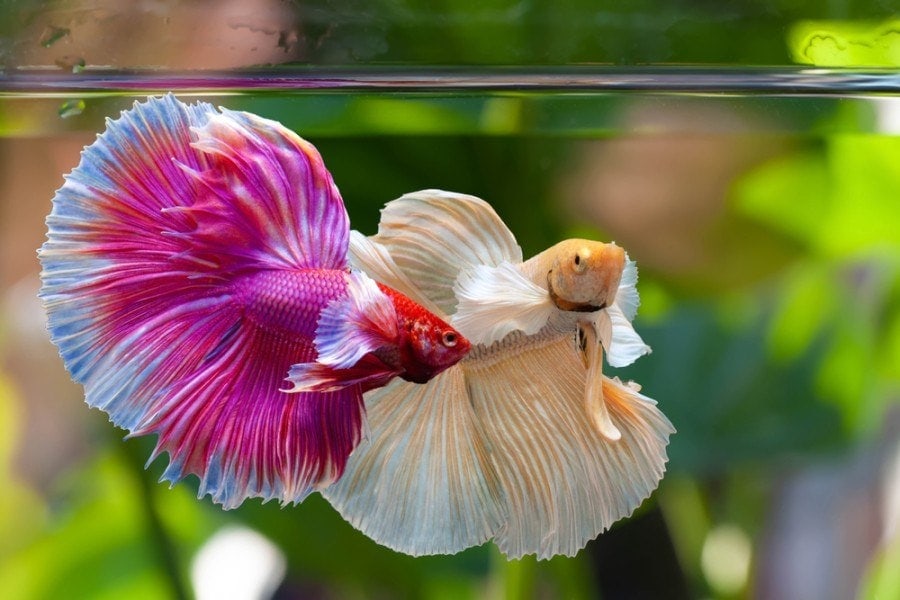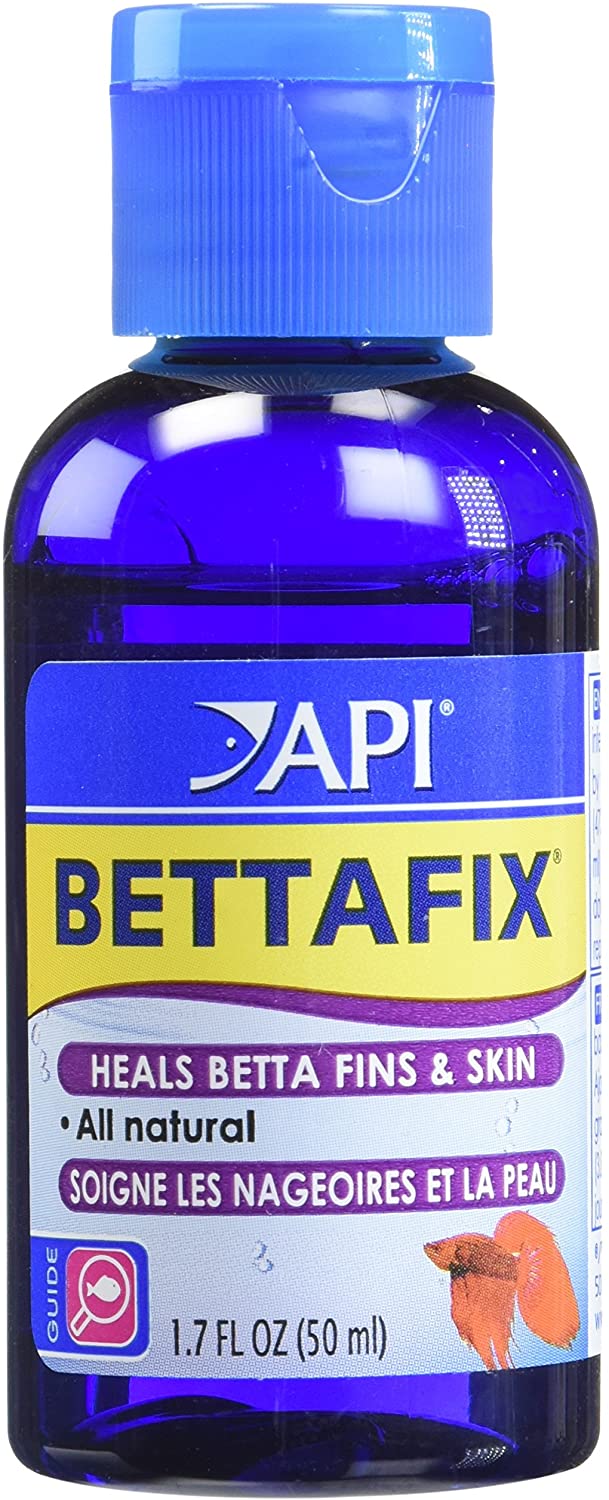Elephant Ear Betta Fish (Dumbo): Care Guide, Pictures, Lifespan & More

Updated on
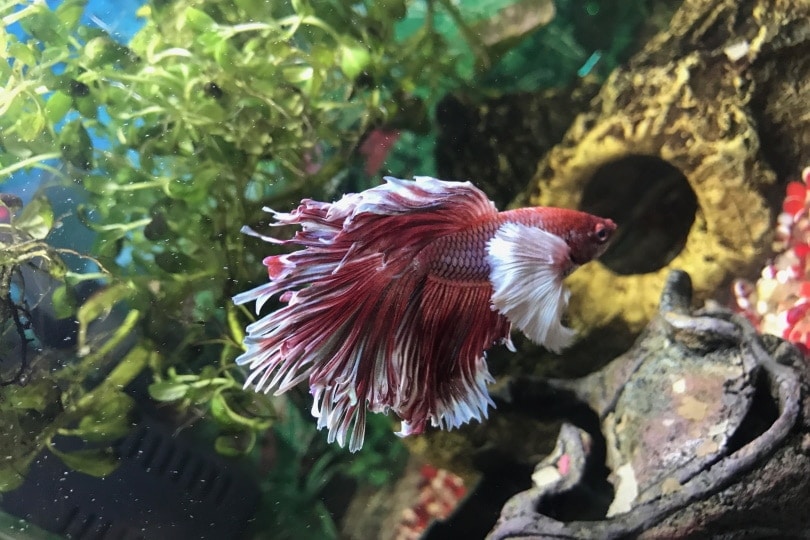
Few fish have as many bright colors and are as easy to take care of as the Elephant Ear betta. But that doesn’t mean there aren’t plenty of mistakes that first-time owners can make.
The good news is that you’ve come to the right place. We walk you through everything that you need to know to keep your Elephant Ear betta alive and enable them to thrive.
Quick Facts about Elephant Ear Betta (Dumbo)
| Species Name: | Betta splendens |
| Family: | Gouramis |
| Care Level: | Low |
| Temperature: | Between 75 and 82 degrees Fahrenheit |
| Temperament: | Aggressive |
| Color Form: | Gray, blue, light green, dull green, brown, red, and pink |
| Lifespan: | 1 year |
| Size: | 2.5 inches |
| Diet: | Mosquito larvae, zooplankton, crustaceans, bloodworms, brine shrimp, fish pellets, and insects |
| Minimum Tank Size: | 5 gallons |
| Tank Set-Up: | Smooth rocks, freshwater plants, and a fine sand substrate |
| Compatibility: | Snails, Pygmy Corydoras, Ember Tetra, Harlequin Rasboras, and female Bettas |
Elephant Ear Betta Overview
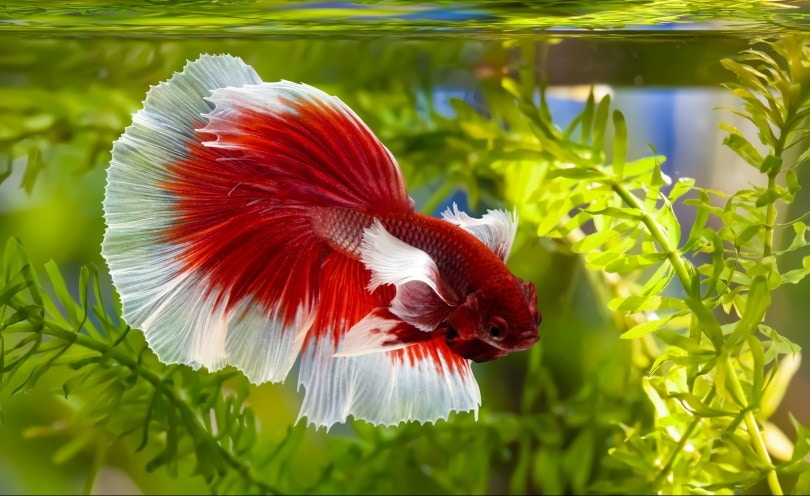
Elephant Ear betta fish are relatively easy to take care of once you get everything set up properly. However, they’re carnivorous fish, making it a challenge to add any new fish to their enclosure. This is especially prevalent if you put multiple males or other bright-colored fish in the same enclosure, but they can get aggressive toward any other fish.
Still, Elephant Ear betta fish come in a wide array of colors, which is one reason that they’re so popular. They’re a great way to brighten up a tank, and a single fish doesn’t require the same massive tank as some other fish. When you pair these benefits with their affordable price, they become an extremely affordable pet that almost anyone can add to their home!
Just don’t take for granted how easy they are to care for because if you don’t keep up with everything that they need, their good health can quickly decline, and you’ll have to start from square one!
How Much Do Elephant Ear Betta Cost?
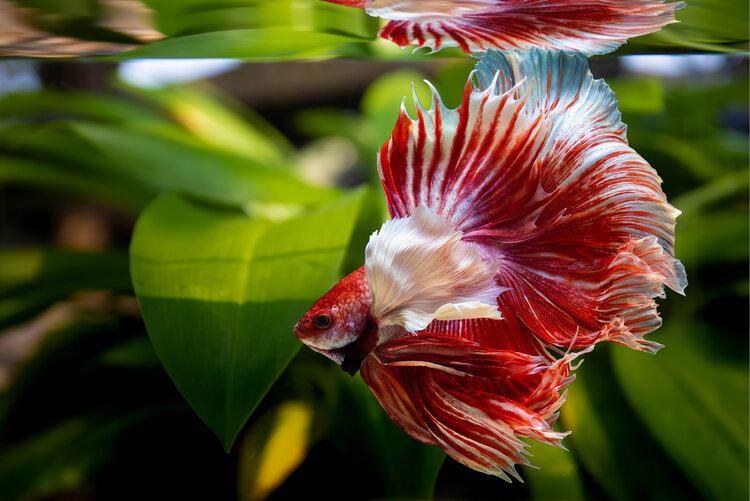
Like most betta fish, the Elephant Ear betta doesn’t cost much. You can find them for anywhere between $10 and $20, depending on the color variations that you choose and where you purchase them from.
They are relatively common, and you can find them at a wide array of pet stores like Petco, PetSmart, and even Walmart, making them easy fish to track down and add to your aquarium.
Typical Behavior & Temperament
While the temperament of an Elephant Ear betta can vary, they’re known to be aggressive fish. Males are especially aggressive, and you can’t house more than one male Elephant Ear betta in the same enclosure. However, you can have multiple females in the same enclosure, and there are certain other fish that you can keep around if you have an Elephant Ear betta with a milder temperament.
However, there is no guarantee that your betta will get along with any other fish. If you plan to try, you need at least a 20-gallon enclosure.
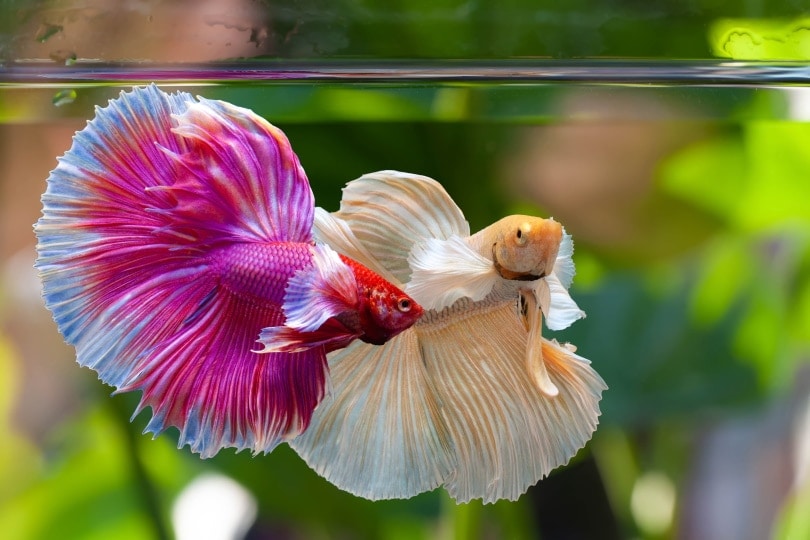
Appearance & Varieties
Elephant Ear betta fish come in three main color variations: grey, dull green, and brown. However, in captivity, they can have much brighter colors due to selective breeding, including shades that would be a disadvantage in the wild.
Moreover, all Elephant Ear betta fish come with a large tailfin that gives off the appearance of large ears when you look at them head-on. This is why they’re known as Elephant Ear or “Dumbo” betta fish. Additionally, male Elephant Ear bettas tend to be slightly larger than females, although this difference usually only accounts for about a ¼ of an inch in size.
Finally, keep in mind that while most Elephant Ear betta fish are a solid color, some of those kept in captivity can have multiple colors.
How to Take Care of Elephant Ear Betta
Habitat, Tank Conditions & Setup
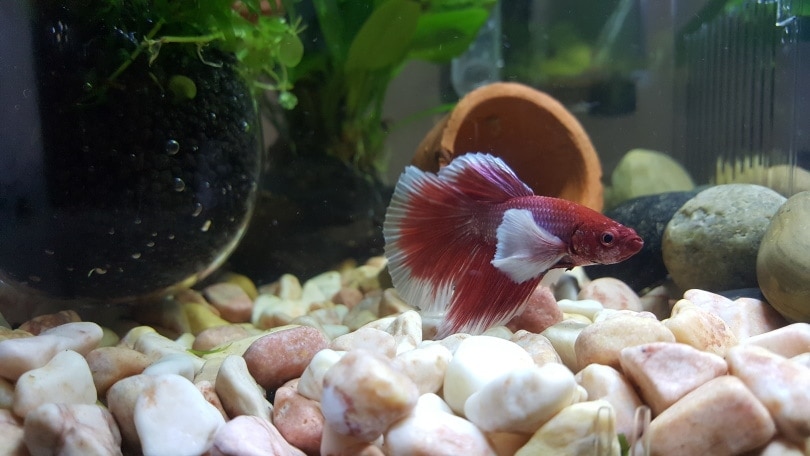
While you only need a 5-gallon tank for a single Elephant Ear betta fish, we recommend something a bit larger. This helps in two different ways. First, it introduces the possibility of adding another fish. While it’s never a guarantee that your Elephant Ear betta fish can live with other fish, having a larger tank certainly helps.
Second, a larger enclosure helps prevent a litany of health concerns that can affect your Elephant Ear betta. In short, if you want your betta to have a long and healthy life, you need a large enough enclosure.
But once you have the right size tank, you’re not done yet. You need to fill that tank with plenty of freshwater plants to help aerate the tank and keep everything healthy. While filters can help with this, nothing does the trick quite like live plants.
Moreover, you need to use a fine sand substrate for the bottom of the tank, at least a couple of inches deep, so the plants have plenty of room to settle in. From there, keep the tank between 75 and 82 degrees Fahrenheit all the time. This usually isn’t a problem during the spring and summer months, but you might need a tank heater during winter.
Additionally, keep the pH level between 6.8 and 7.5. The temperature and pH levels are standard for many freshwater fish, but your fish will die if you don’t maintain them.
Finally, when putting in rocks or any other decorations, ensure that everything has a smooth edge. Your Elephant Ear betta has a large and sensitive tail fin, and rough edges can lead to that fin getting caught. If that happens, your betta can be injured or even killed, so pick out the right tank decorations the first time!
Are Elephant Ear Bettas Good Tank Mates?
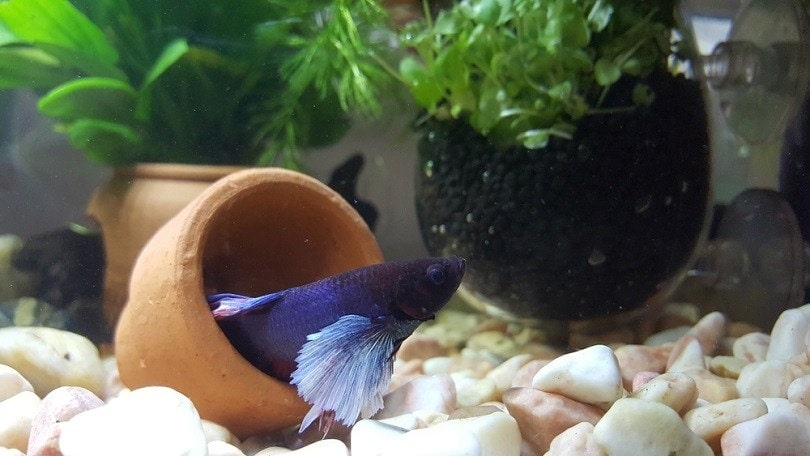
In short, Elephant Ear betta fish are terrible tank mates. While you can safely pair them with a snail, for example, there is no guarantee that you can pair them with other fish.
For best results, you need a large tank, but even this doesn’t ensure success. Whatever you do, never pair two male Elephant Ear betta fish in the same tank. They will become extremely aggressive and literally battle to the death. However, if you have female Elephant Ear betta fish, you can put multiple ones in the same enclosure.
Keep in mind that if you have a female and male in the same enclosure, they will mate, and this means you’ll eventually have multiple males that will fight each other.
Some other fish species that you can try are Pygmy Corydoras, Ember Tetra, and Harlequin Rasboras, but they still might fight, depending on your Elephant Ear betta’s temperament.
What to Feed Your Elephant Ear Betta
The best food that you can get for your Elephant Ear betta fish is Betta-specific pellets or flakes. These foods make a balanced diet for your Betta and have all the nutrients that they need.
While you can feed your Elephant Ear betta more specific foods, like bloodworms and insects, these are best as treats and given sparingly. Unless you can mix up their food enough to give them a varied diet, those can’t be their primary sources of food.
Also, adding too many treats like bloodworms in addition to their flakes and pellets can cause them to overheat and can create future health problems.
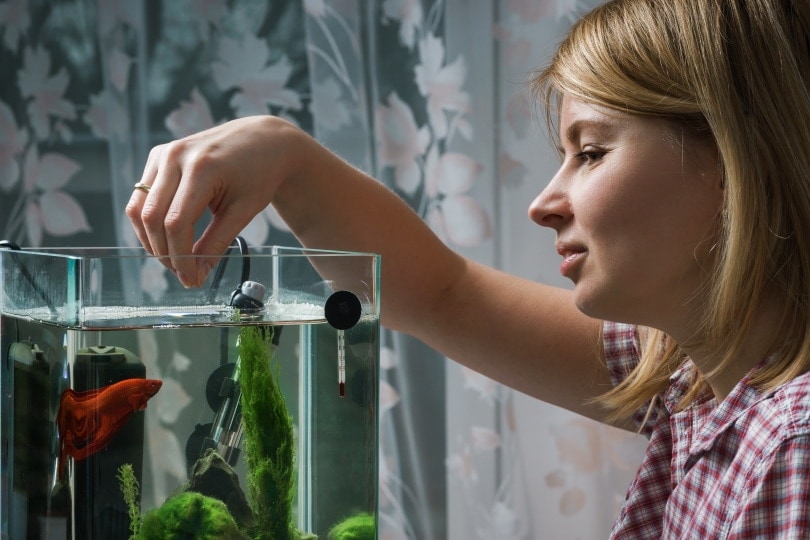
Keeping Your Elephant Ear Betta Healthy
Keeping your Elephant Ear betta healthy can be deceptively easy. If you have a large enough enclosure with freshwater plants and a snail or two, there’s not much that you need to do to keep them healthy. The tank is a bit of a self-contained ecosystem, which means all you need to do is keep up with your fish’s diet, and you can buy specific betta fish food that makes this easy.
However, keeping your fish tank clean and free of algae can be more complicated than it sounds. You need a good filtration system and a location without a ton of direct sunlight.
Even then, you might find yourself needing to clean out the tank every month. If you don’t, your Elephant Ear betta fish can quickly get sick. Also, be sure to stay on top of the water temperature and pH levels. These are easy to forget about, but there can be disastrous results if they fall out of acceptable ranges.
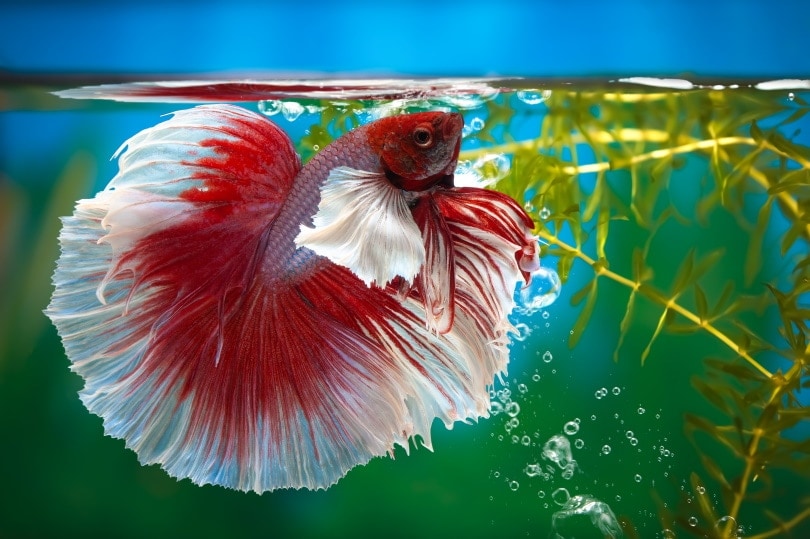
Breeding
While you might think that you can simply put a female and a male betta in the same tank and watch them breed, you’ll likely be disappointed. It’s better to have a separate breeding tank without any substrate because of how fragile the babies will be.
From there, you’ll need the male Elephant Ear betta around to take care of the nest. But as soon as the fry is free-swimming, you will need to remove the male to prevent him from eating the babies. Moreover, once the new betta fish get large enough, you’ll need to rehome them or separate them. The best way to do this is to find new owners.
The good news is that it’s not overly hard to breed this fish, but it can require a bit of a learning curve to get it right.
Are Elephant Ear Betta Suitable for Your Aquarium?
If you already have a thriving community aquarium, you probably don’t want to add an Elephant Ear betta fish. They’re simply far too aggressive, and there’s a good chance that you’ll end up with a few dead fish.
However, if you have an empty tank or a female Betta, an Elephant Ear betta might be a good addition. Just be sure to only add a female to another enclosure with a female. If you have an empty tank, you can add whatever Elephant Ear betta fish that you would like, as long as the tank is over 5 gallons in size.
Either way, you’ll get a beautiful fish, and that alone makes them worth all the headache and trouble!
Featured Image Credit: Brad Rice, Shutterstock

